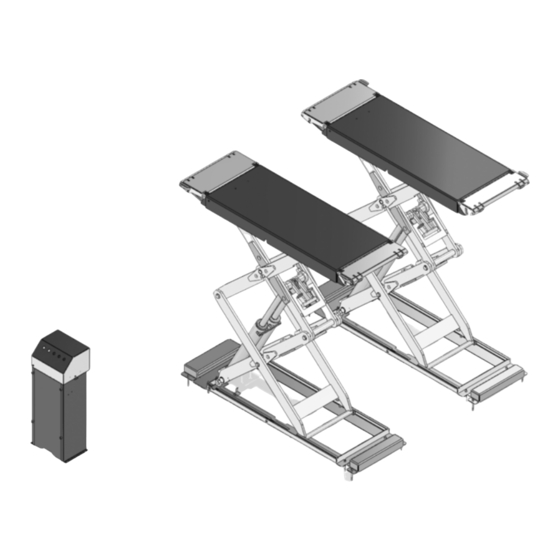
Table of Contents
Advertisement
TWIN F III 3.0 | 4.0
Scissors Lift
Original Operating Instructions
BA082601-en
Pos: 1 /Technische Dokumentation/Hebetechnik/TWIN/082601
TWIN F III 3.0 / 4.0/BA/Inhalt: 0826 Titelbild @ 42\mod_1435573920051_0.docx @ 2262565 @ @ 1
Pos: 2 /-----Format-----/MANUELLER UMBRUCH Seitenumbruch @ 0\mod_1134403577687_0.docx @ 1277 @ @ 1
Fehler! Verwenden Sie die Registerkarte 'Start', um Name dem Text zuzuweisen, der hier angezeigt werden soll.Fehler! Verwenden Sie
die Registerkarte 'Start', um Name dem Text zuzuweisen, der hier angezeigt werden soll.Fehler! Verwenden Sie die Registerkarte
'Start', um Name dem Text zuzuweisen, der hier angezeigt werden soll.
Advertisement
Table of Contents

Summarization of Contents
Safety
Introduction to Safety
Provides an overview of the manual and its importance for safe operation, emphasizing compliance with instructions.
Understanding Safety Symbols
Explains important safety symbols used throughout the manual to indicate hazards, potential injury, or property damage.
Intended Use of the Lift
Details the specific applications for which the lift is designed, emphasizing safe lifting of motor vehicles and respecting load capacity.
Prohibited Uses of the Lift
Lists inappropriate uses of the lift to prevent damage or injury, such as climbing on supports or transporting persons.
Safety Instructions for Commissioning
Outlines critical safety measures for the installation and initial setup of the lift, requiring authorized service personnel.
Safety Instructions for Operation
Covers essential safety guidelines for the daily operation of the lift, including operator training and equipment checks.
Safety Instructions for Servicing
Specifies safety procedures for maintenance and repair work, requiring authorized personnel and proper lockout procedures.
Handling Hydraulic Fluid Safely
Provides guidance on safe handling of hydraulic fluid, including spill response and personal protection measures.
Mobile Lift Transport Frame Safety
Details specific safety requirements when the lift is used with a transport frame for mobility, including surface and positioning.
Action for Defects or Malfunctions
Instructs on immediate actions to take when the lift exhibits faults or malfunctions, such as uncontrolled movement.
Accident Response Procedures
Guides on first aid and reporting procedures in case of an accident involving the lift, emphasizing immediate reporting.
Description of the Lift
General Lift Information
Offers a general overview of the lift's design, including its scissors superstructure and master-slave hydraulic system.
Technical Specifications
Lists detailed technical specifications such as load capacity, dimensions, working pressure, voltage, and weight.
Sample Nameplate Details
Shows an example of the lift's nameplate, detailing manufacturer, model, serial number, and other essential technical data.
Operation Procedures
Operator Qualifications
Outlines the essential qualifications and training requirements for lift operators, including age and instruction.
Main Switch Functionality
Explains the function and usage of the main switch, including its role as an emergency stop and power control.
Lift Control Panel Overview
Describes the various control elements of the lift, such as buttons, indicators, and switches for operation.
Driving Vehicles onto the Lift
Provides step-by-step instructions and safety tips for safely driving vehicles onto the lift, emphasizing ramp security.
Proper Use of Support Blocks
Details the correct procedure for using support blocks to ensure safe lifting of vehicles, including block condition and placement.
Stacking Support Blocks
Explains the safe method for stacking support blocks, specifying allowed types and quantities per lifting point.
Raising and Lowering the Lift
Describes the process of raising and lowering the lift, including button operation and safety checks.
Ramp Operation
Details how to operate and reposition the lift's ramp using the integrated lateral handle.
Bleeding the Hydraulic System
Explains that bleeding the hydraulic system is a task for authorized service technicians.
Manual Lowering Procedure
Outlines the procedure for manual lowering of the lift, requiring authorized personnel and specific solenoid valve operations.
Equalizing Support Plates
Describes the process for leveling the support plates, requiring specific conditions and key switch operation.
Lift Operation with Mobile Transport Frame
Details the preparation and transport of the lift when equipped with a mobile transport frame, including attachment.
Maintenance Information
Maintenance Schedule
Presents a schedule for regular maintenance tasks based on intervals like 3, 6, 12 months, and 6 years.
Annual Inspection Requirements
Specifies requirements and procedures for annual safety inspections of the lift, emphasizing professional execution.
Hydraulic Fluid Refilling
Guides on checking and refilling the hydraulic fluid, specifying fluid type, viscosity, and frequency.
Lift Cleaning Instructions
Provides instructions on how to clean the lift, warning against aggressive cleaning agents and recommending specific treatments.
Using Original Spare Parts
Emphasizes the importance of using only original spare parts supplied by the manufacturer for reliable operation.
Troubleshooting Common Errors
Offers solutions for common errors and malfunctions, with diagnosis and remedy steps for lift operation issues.
Service Lifetime and End-of-Life
Expected Service Lifetime
States the designed load cycles and the need for periodic evaluation of the product's life expectancy.
Dismantling Procedures
Details that decommissioning and dismantling must be done by authorized and trained personnel.
Equipment Disposal
Instructs to take the equipment to a specialized waste management company for correct disposal of components and liquids.
Declaration of Conformity Contents
Lists the contents of the Declaration of Conformity, including product type, directives, and standards.




Need help?
Do you have a question about the TWIN F III 3.0 and is the answer not in the manual?
Questions and answers